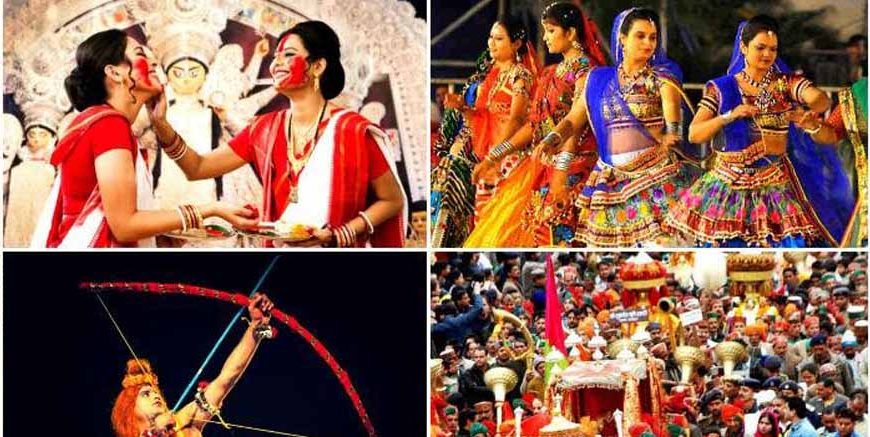India being a country of varied cultures and traditions has many festivals round the year. Out of all of these festivals, the festival of Dussehra has to be considered the most important as it celebrates victory of light over darkness. The festival is also called Vijayadashami and is celebrated with a lot of fun and excitement in all the different areas of the country. Explore how people of different states of India celebrate the popular festival Dussehra enthusiastically and whole-heartedly.
Table of Content:
- Why Do We Celebrate Dussehra?
- How Is Dussehra Celebrated in India?
- Dussehra Traditions
- Dussehra Celebration in India
Why Do We Celebrate Dussehra?
Thus Dussehra derives from slot; Dasha-hara means ‘remover of bad fate’ and the festival is celebrated for a number of reasons deeply ingrained in Indian mythology and tradition. The common story associated with this festival is the Ramayana wherein Lord Rama triumphs over the demon king Ravana. This victory represents the victory of the good over the bad in the world.
In some of the states in India, Dussehra also symbolizes the last day of Durga Puja festival that rejoices in the victory of the goddess Durga over the buffalo demon Mahishasura. This way, two celebrations complement each other and demonstrate how rich and diverse Indian culture is when various mythological narratives merge into a single theme – the victory.
The festival is people’s call to get rid of the evil inside them and be good to each other. It is replete with introspection, rebirth and rededication towards the right path back to moral integrity.
How Is Dussehra Celebrated in India?
Thus, it can be noted that the celebration of Dussehra in India reflects the true diversity of the country. Indeed, while the superficial aspect of the festival could be observed from circle to circle and looks quite alike across the nation, the actual details of the celebration of Dussehra in terms of rituals and practices vary from region to region which makes the festival genuinely pan-Indian.
In North India places include Delhi, Varanasi and Lucknow the grand Ramlilas are performed in the period prior to Dussehra. These performances end on the Dussehra day where huge gigs of Ravana along with his brother Kumbhakarna and son Meghnad are set on fire which signify the victory of truth against all the evils.
In contrast, West Bengal and other eastern states focus on the Durga Puja aspect of the festival. Carpented ‘pandals’ or temporary halls are constructed which house beautifully decorated idols of Goddess Durga and people get involved in praying, singing, dancing and enjoying bountiful meals for five to eight days depending upon the customs. The festival culminates with this idol immersions wherein the gods and goddesses are immersed in water bodies and the goddess Durga goes back to her celestial home.
Karnataka and Tamil Nadu the southern states of India have their different cultures. The festival is celebrated in Mysore where there is taking out of a carnival-like procession of decorated elephants, dancers and musicians and the members of the royal family involve themselves in some special rituals only during the festival. This parade called ‘Jamboo Savari’ is very colorful and highly popular among international tourists who visit Mysore.
Dussehra Traditions:
The traditions of Dussehra are as varied as they are fascinating. Here are some notable customs observed across different regions:
- Ayudha Puja:
- Kullu Dussehra:
- Bathukamma:
- Sindoor Khela:
- Ramlila:
Is it possible you find people joyfully participating in the Ayudha Puja festival in South India especially in Karnataka and Tamil Nadu? This entails pledging respect or rather asking for blessings on the items people use in their day to day life like axe, knife, musical instruments, and cars to mention but a few by hailing their utility and requesting the blessing to acquire more.
There is a Dussehra festival of Kullu valley in Himachal Pradesh which is celebrated for a week at least. That starts on vijaya dashami and includes the gathering of local gods & goddesses in palanquins for the fair of dhalpur maidan.
The women in the state of Telangana celebrate Bathukamma which is a festival all associated with flowers and falls during the time of Dussehra. They create beautiful flower stacks, dance around them, and finally immerse them in water bodies.
On the last day of Durga puja which is on Dussehra, married ladies apply sindoor on the head of the idol of Goddess Durga apart from that they apply sindoor also on her husband to enjoy the feeling of being a woman and wife respectively.
The Ramlila presentation of Ramayana is embraced by UNESCO as “Intangible Cultural Heritage of Humanity”. These performances, often spanning several days, keep the epic tale alive in public memory.
Dussehra Celebration in India:
The Dussehra festival of India is looking very bright, people gathering in large gatherings and enjoying the festival with the same passion and devotion. While traditions vary, certain elements are common across the country :
- Fasting and Feasting:
- New Beginnings:
- Exchange of Apta Leaves:
- Vijaya Dashami:
- Cultural Programs:
Many people observe fasts during the nine days preceding Dussehra (Navratri). The festival day itself is marked by elaborate feasts featuring traditional delicacies.
It is therefore a good time to begin new businesses as well as patronize new items in the market. Many people buy new vehicles or begin new projects on this day.
In Maharashtra people can pay their dues of gold by the leaves of Apta tree (ITR referred to as golden shower tree) for prosperity and good wishes.
This is one of the days that children especially in Asian countries are taken to school to start their education. This is normally done for schools and colleges where special events are organized for this specific occasion.
Song and dance programs and other cultural shows are held as part of Dussehra festivity as a true representation of Indian culture.
Variation in the celebration of dussehra in different regions of India adds up to the fact of the country’s diverse culture. While it is the celebration of effigy of Ravana in the northern region, Puja of Durga in the eastern region, Ram’s puja in vehicle in the southern region, or Dussehra at Kullu in the on the hills each give a different color to the great festive picture of India.
It would be prudent to offset thinking about the time of Dussehra and focus on what the festive shows – victory of the good over the bad. This is why the essence of Dussehra is so befitting today’s world; it is a call to carry forward the fight against the wrong, to uphold the right and remain impassioned in our endeavors.
Therefore, this Dussehra, let’s try to learn about a different tradition followed by different regions. Try to watch a Ramlila, if you are in North India or try to be part of Sindoor Khela if you are in Bengal. Hence, the failure to acknowledge the different ways through which people celebrate also denies the cultural diversity benefit of enhancing the unity of the nation.
Happy Dussehra to all!
For more such interesting blogs, Visit EuroKids
















